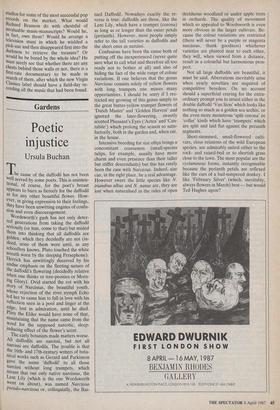Gardens
Poetic injustice
Ursula Buchan
The cause of the daffodil has not been well served by some poets. This is uninten- tional, of course, for the poet's breast appears to burn as fiercely for the daffodil as for any other beautiful flower. How- ever, in giving expression to their feelings, they have been unwitting engines of confu- sion and even discouragement. Wordsworth's gush has not only deter- red generations from taking the daffodil seriously (or him, come to that) but misled them into thinking that all daffodils are golden, which they decidedly are not (in- deed, none of them were until, as any schoolboy knows, Pluto touched the white wreath worn by the sleeping Persephone). Herrick has unwittingly deceived by his undue emphasis on the fleeting nature of the daffodil's flowering (decidedly relative When one thinks or tree-peonies or Morn- ing Glory)'. Ovid started the rot with his story of Narcissus, the beautiful youth, whose rejection of the river nymph Echo led her to cause him to fall in love with his reflection seen in a pool and linger at the edge, lost in admiration, until he died. Pliny the Elder would have none of that, maintaining that the name came from the Word for the supposed narcotic, sleep- inducing effect of the flower's scent. The early botanists made matters worse. All daffodils are narcissi, but not all narcissi are daffodils. The trouble is that the 16th- and 17th-century writers of bota- nical works such as Gerard and Parkinson gave the name 'daffodil' to all those narcissi without long trumpets, which meant that our only native narcissus, the Lent Lily (which is the one Wordsworth went on about), was named Narcissus pseudo-narcissus or, colloquially, the Bas- tard Daffodil. Nowadays exactly the re- verse is true: daffodils are those, like the Lent Lily, which have a trumpet (corona) as long as or longer than the outer petals (perianth). However, most people simply refei to the tall varieties as daffodils and the short ones as narcissi.
Confusions have been the cause both of putting off the inexperienced (never quite sure what to call whdt and therefore all too ready not to bother at all) and also of hiding the fact of the wide range of colour variations. If one believes that the genus Narcissus consists solely of yellow flowers with long trumpets one misses many opportunities. I should be sorry if I res- tricted my growing of this genus simply to the great butter-yellow trumpet flowers of `Dutch Master' and 'Golden Harvest' and ignored the later-flowering, sweetly scented Pheasant's Eyes (`Actea' and 'Can- tabile') which prolong the season so satis- factorily, both in the garden and, when cut, in the house.
Intensive breeding for size often brings a concomitant coarseness (small-species tulips, for example, usually have more charm and even presence than their taller but stiffer descendants) but this has rarely been the case with Narcissus. Indeed, size can, in the right place, be a real advantage. However sweet the little species like N. triandrus albus and N. nanus are, they are lost when naturalised in the rides of open deciduous woodland or under apple trees in orchards. The quality of movement which so appealed to Wordsworth is even more obvious in the larger cultivars. Be- cause the colour variations are restricted (there will never be a purple or magenta narcissus, thank goodness) whichever varieties are planted near to each other, they will, when viewed from a distance, result in a colourful but harmonious pros- pect.
Not all large daffodils are beautiful, it must be said. Aberrations inevitably arise when yearly novelties are required of competitive breeders. On no account should a superficial craving for the extra- ordinary prompt you to invest either in the double daffodil 'Van Sion' which looks like nothing so much as a golden sea urchin, or the even more monstrous 'split corona' or `collar' kinds which have 'trumpets' which are split and laid flat against the perianth segments.
Short-stemmed, small-flowered culti- vars, close relations of the wild European species, are admirably suited either to the rock- and raised-bed or to shortish grass close to the lawn. The most popular are the cyclamineus forms, instantly recognisable because the perianth petals are reflexed like the ears of a bad-tempered donkey. I like 'February Silver' (which, inevitably, always flowers in March) best — but would Ted Hughes agree?


























































 Previous page
Previous page